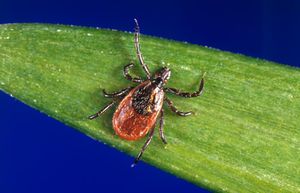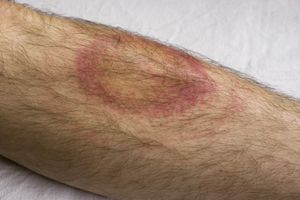Borrelia burgdorferi and Lyme Disease: Difference between revisions
Bartholomewa (talk | contribs) No edit summary |
Bartholomewa (talk | contribs) |
||
| Line 20: | Line 20: | ||
==Borrelia burgdorferi Description and Structure== | ==Borrelia burgdorferi Description and Structure== | ||
<br> | <br>Borrelia burgdorferi is a Gram-negative bacterium belonging to the class Spirochaetes. This bacterium is helical and has both an inner and outer membrane as well as a flexible cell wall. The cell is usually 1m wide, but can be up to 10-25 m long. Bacteria of the class spirochaetes have flagella located on the inside of the periplasm in between the inner and outer membranes. The flagellum along with the helical structure of the bacterium allows the bacterium to migrate through viscous fluids and burrow through various tissues. As a result, this cell is highly invasive. B. burgdorferi is also known for its outer surface proteins OspA and OspC have been studied extensively and have a role in transmission of the bacteria into the host cell. | ||
The metabolism of this cell is limited, therefore; B. burgdorferi relies on their host for energy precursors. Its genome encodes transport proteins such as ABC transporters. B. burgdorferi also codes for enzymes and proteins that are used in the phosphotransferase system. The host serum as well as the environment are targets for these transport systems. The genome of this bacterium is distinctive. It consists of one linear chromosome of 910,725 base pairs long with at least 17 linear and circular plasmids that combine to a size of more than 533,000 base pairs. As a result of its large number of plasmids, the genetic organization of B. burgdorferi is specialized. | |||
.<br> | |||
==What is Lyme Disease?== | ==What is Lyme Disease?== | ||
Revision as of 19:28, 24 April 2013
History
At right is a sample image insertion. It works for any image uploaded anywhere to MicrobeWiki. The insertion code consists of:
Double brackets: [[
Filename: PHIL_1181_lores.jpg
Thumbnail status: |thumb|
Pixel size: |300px|
Placement on page: |right|
Legend/credit: Electron micrograph of the Ebola Zaire virus. This was the first photo ever taken of the virus, on 10/13/1976. By Dr. F.A. Murphy, now at U.C. Davis, then at the CDC.
Closed double brackets: ]]
Other examples:
Bold
Italic
Subscript: H2O
Superscript: Fe3+
Borrelia burgdorferi Description and Structure
Borrelia burgdorferi is a Gram-negative bacterium belonging to the class Spirochaetes. This bacterium is helical and has both an inner and outer membrane as well as a flexible cell wall. The cell is usually 1m wide, but can be up to 10-25 m long. Bacteria of the class spirochaetes have flagella located on the inside of the periplasm in between the inner and outer membranes. The flagellum along with the helical structure of the bacterium allows the bacterium to migrate through viscous fluids and burrow through various tissues. As a result, this cell is highly invasive. B. burgdorferi is also known for its outer surface proteins OspA and OspC have been studied extensively and have a role in transmission of the bacteria into the host cell.
The metabolism of this cell is limited, therefore; B. burgdorferi relies on their host for energy precursors. Its genome encodes transport proteins such as ABC transporters. B. burgdorferi also codes for enzymes and proteins that are used in the phosphotransferase system. The host serum as well as the environment are targets for these transport systems. The genome of this bacterium is distinctive. It consists of one linear chromosome of 910,725 base pairs long with at least 17 linear and circular plasmids that combine to a size of more than 533,000 base pairs. As a result of its large number of plasmids, the genetic organization of B. burgdorferi is specialized.
.
What is Lyme Disease?
Include some current research in each topic, with at least one figure showing data.
Symptoms
Include some current research in each topic, with at least one figure showing data.
Treatment
Overall paper length should be 3,000 words, with at least 3 figures.
Adhesion Mechanisms
Future Work
Concluding Remarks
References
Edited by student of Joan Slonczewski for BIOL 238 Microbiology, 2009, Kenyon College.



